Burlingham’s flock of Seagulls - Part 3
Burlingham’s flock of Seagulls - Part 3
To read Part 1 click here or Part 2 click here
Not Really Seagulls
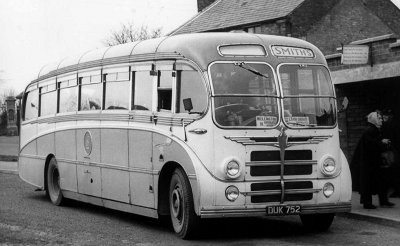 Burlingham’s bodywork for front engined chassis evolved from the “full fronted” Sun Saloon model of the late 1940s (some later versions of which carried the Seagull “tank” moulding on their sides) into this nameless “Seagull lookalike”. The 1953 body on this example – 1946 vintage AEC 0662 Regal DUK 752 – was ordered by Don Everall of Wolverhampton. The rejuvenated vehicle passed to W Smith & Sons of Donnington Wood in 1957 and is seen here on one of their local stage carriage services. When Smiths sold out to Hoggins (Pilot Coaches) of Wrockwardine Wood in March 1959 it was sold to Leadbetter of Sutton Coldfield, famous at that time for its selection of geriatric coaches.
Burlingham’s bodywork for front engined chassis evolved from the “full fronted” Sun Saloon model of the late 1940s (some later versions of which carried the Seagull “tank” moulding on their sides) into this nameless “Seagull lookalike”. The 1953 body on this example – 1946 vintage AEC 0662 Regal DUK 752 – was ordered by Don Everall of Wolverhampton. The rejuvenated vehicle passed to W Smith & Sons of Donnington Wood in 1957 and is seen here on one of their local stage carriage services. When Smiths sold out to Hoggins (Pilot Coaches) of Wrockwardine Wood in March 1959 it was sold to Leadbetter of Sutton Coldfield, famous at that time for its selection of geriatric coaches.
(R Marshall via B M Gough)
The unpopularity of the Mark 6 and 7 Seagulls was not entirely responsible for the declining sales of coach bodywork at Burlingham. From 1951 onwards the company had offered a 36-41 seat design on Bedford SB and other front engined chassis types. Although visually very similar to the original Seagull, this design was never given an official name by Burlingham. There was also a shorter variant of this body style suitable for the modernisation of Bedford OB and OWBs, and this soon became known among its (mainly Scottish) customers as the “Baby Seagull”. Once again, this appellation was never an official one as far as Burlingham were concerned, although its use undoubtedly spread to some of the company’s rank and file workers.
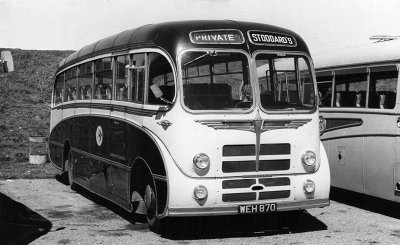
Most of this style of “Seagull lookalike” bodywork were fitted to Bedford SB chassis such as SBG 36 seater WEH 870, delivered to Percy Stoddard of Cheadle in 1955. Stoddard used it on his market day stage carriage services to Cheadle and Uttoxeter from the villages between the two Staffordshire towns.
(Neville Mercer Collection)
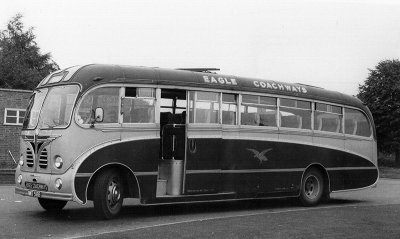
Another Bedford SBG, but with slightly different front end styling and 41 seats. NNT 588 was delivered to TG Smith (Smiths Eagle) of Trench in 1956 and gave them 15 years of its life before passing to an operator in Willenhall for further use.
(Neville Mercer Collection)
Production of the so-called “Baby Seagull” came to an end in the mid 1950s but sales of the Bedford SB body (which gradually evolved to incorporate some of the features of the contemporary Seagull designs) continued throughout the decade. By 1958 sales of the SB body had outdistanced those of the Twilight Zone versions of the Seagull, so naturally Burlingham’s management thought that it would be a good idea to drastically redesign their offering for the SB. Note the element of sarcasm in that statement.
The gargoylish result of this “redesign” emerged in early 1959 and was an insult to the Bedford and Thames chassis which bore it. The front end of this abomination defied description (space helmet for a very fat sheep?) while its rear end shared the unpleasant “chopped off” look of the Seagull Mark 7. Less than 50 were sold, presumably to operators who didn’t care what their coaches looked like, and the type soon picked up a variety of unofficial names including “The Pig”, “The Sea-Cow”, and the “Burlingham Dodo”.
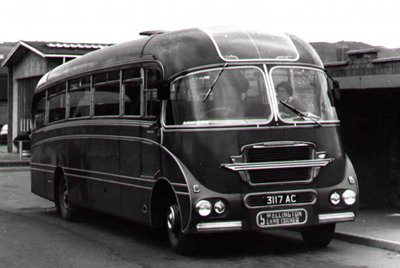 For 1959 Burlingham came up with this new design for front engined chassis. If you look at it for too long it will turn you into stone. Bedford SB3 37 seater 3117 AC was new to De Luxe of Mancetter, passing to Price (Excelsior Coaches) of Wrockwardine Wood in September 1964. Price used it on their “Telford Rota” services (where it is seen here) for just one year before sending it off into the hills along the Welsh border. Remote from the public’s gaze it gave further service to two coach operators in Bishops Castle and then to the almost mythical Clun Valley Motor Services who scrapped it in 1972.
For 1959 Burlingham came up with this new design for front engined chassis. If you look at it for too long it will turn you into stone. Bedford SB3 37 seater 3117 AC was new to De Luxe of Mancetter, passing to Price (Excelsior Coaches) of Wrockwardine Wood in September 1964. Price used it on their “Telford Rota” services (where it is seen here) for just one year before sending it off into the hills along the Welsh border. Remote from the public’s gaze it gave further service to two coach operators in Bishops Castle and then to the almost mythical Clun Valley Motor Services who scrapped it in 1972.
(B Mel Gough Collection)
Sales figures for 1959 were astonishingly low in both the heavyweight and lightweight categories and at the end of the year Burlingham’s managers announced an entirely new range in a desperate attempt to save the company. For lightweight chassis (Bedford/Thames) the new design was to be known as the Seagull 60, the first time that the Seagull name had been officially applied to a design for front-engined vehicles. The “60” part referred to the year in which it would be delivered. The bodywork was a vast improvement over the grotesque 1959 design but still no beauty queen if compared to the offerings on similar chassis by Duple and Plaxton. On the positive side it was better looking than Harrington’s Crusader, but that was an easy target to reach.

After the “controversial” styling of the 1959 model, its successor’s appearance could only be an improvement. The Seagull 60 design is represented here by a Thames 570E, UAW 983, delivered to Whittle of Highley in January 1960 as fleet number 14, and seen in this shot on a private hire somewhere in London. In March 1961 it was sold to a Scottish operator.
(Chris Elmes Collection)
Sales of the Seagull 60 were good, especially when compared to those of the 1959 body, but the type had its own fatal flaw. The design featured a raised Perspex section in the centre of the roof which ran all the way from front to rear. The idea was to increase the amount of natural light in the interior. It soon became evident that the Perspex part admitted rainwater as well as light due to inadequate rubber sealing around its edges and joints. The fault could be corrected, but at considerable expense to Burlingham both in terms of money and reputation.
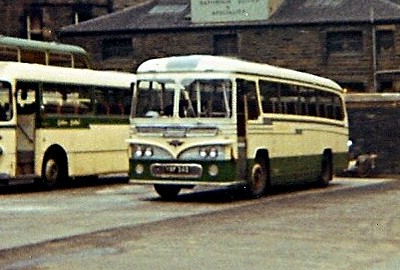 Burlingham had hoped that the Seagull 70 would recover some of the sales on heavy-weight chassis which had been lost by the unpopular Seagull Marks 6 and 7, but the largest orders came from Scottish Omnibuses Ltd (for eleven) and Yorkshire Traction (for six) and less than 50 were built. The SOL machines were luxurious 34-seat touring coaches on AEC Reliance chassis and were delivered in 1961 in a non-standard cream and maroon livery. They exchanged this scheme for SOL's traditional cream and apple green colours at their first repaint. This one is YSF 242 fleet no B11
Burlingham had hoped that the Seagull 70 would recover some of the sales on heavy-weight chassis which had been lost by the unpopular Seagull Marks 6 and 7, but the largest orders came from Scottish Omnibuses Ltd (for eleven) and Yorkshire Traction (for six) and less than 50 were built. The SOL machines were luxurious 34-seat touring coaches on AEC Reliance chassis and were delivered in 1961 in a non-standard cream and maroon livery. They exchanged this scheme for SOL's traditional cream and apple green colours at their first repaint. This one is YSF 242 fleet no B11
(Chris Hough Collection)
For heavyweight underfloor engined chassis of AEC and Leyland manufacture the Seagull Mark 7 was replaced by the Seagull 70. As this too was introduced for delivery in 1960, the “70” part of the name was entirely meaningless. Like the Seagull 60, the Seagull 70 wasn’t an ugly vehicle, merely not that attractive when compared to its contemporaries –which in this case included the stunning Harrington Cavalier, an Esmeralda to the Crusader’s Quasimodo. Many observers found the Seagull 70’s front end particularly objectionable, but it wasn’t really that bad until you parked one next to a Cavalier. To the disappointment of Burlingham’s managers Ribble chose not to order the Seagull 70 and eventually bought the Harrington alternative. Most operators followed suit and sales of the Burlingham heavyweight design barely passed the 30 mark.
At this point it became obvious that Burlingham could no longer continue as an independent bodywork manufacturer, and in August 1960 the company was acquired by its London-based competitor Duple. Ten years earlier, as Burlingham had proudly displayed its original Seagull at Earls Court, the Duple stand at the same Commercial Motor Show had introduced the Vega design for the Bedford SB. Both the Seagull and the Vega had been enormous successes for their respective manufacturers, but while Duple had consistently offered improved versions of the Vega and slightly longer Super Vega, Burlingham had squandered all of its own goodwill by producing designs which became less attractive as the decade progressed. It was a dog-eat-dog industry and by 1960 Duple was still a healthy Rottweiler while Burlingham had become an incontinent old pug.
The Duple Years
In the short term the Burlingham name remained in use for products made at the Blackpool factory. The Seagull 70 continued to be produced in penny numbers and the Seagull 60 metamorphosed into the Seagull 61 (with a revised roof design and lots of chrome work at the front end). For the 1962 season the Seagull 70 was still in the catalogue (although none were sold), the Seagull 61 magically became the Seagull 62 (the only change being its name), and an alternative body style for Bedford/Thames chassis (with the unfortunate name of the Burlingham Gannet) was offered for those who found the final Seagull range visually unacceptable. The Gannet sold in modest numbers (dozens rather than hundreds), but not as modestly as the Seagull 62 which didn’t even reach double figures.
By the start of the 1963 season the Burlingham name had disappeared and products made at the Blackpool premises were being marketed under the name of Duple (Northern). Burlingham’s final design, the Kestrel (a 41-seater intended to replace the Seagull 70 on heavyweight chassis) had never gone beyond the drawing-board stage, but two variations on the Kestrel theme with very similar styling did achieve production status.
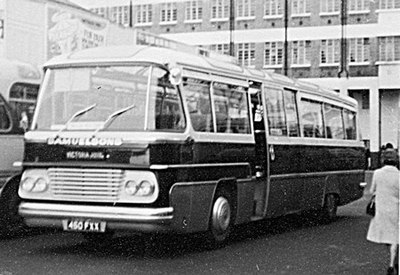 The rarest of all Burlingham designs, the Dragonfly, was marketed as a Duple (Northern) product. Samuelsons fleet of four 49-seaters on AEC 4U3RA Reliance chassis was delivered in 1963 and accounted for two-thirds of the type's production. A major stage-carriage operator until the creation of London Transport in 1933, Samuelsons had later become a subsidiary of London Coastal Coaches (the BET/BTC joint venture which owned Victoria Coach Station). By the 1960s it was specialising in sightseeing tours and airport transfer work, most of the latter for Gatwick-based British United Airways. The majority of Samuelsons' fleet, including Dragonfly 450 FXX, were painted in the BUA livery of black, grey, and white.
The rarest of all Burlingham designs, the Dragonfly, was marketed as a Duple (Northern) product. Samuelsons fleet of four 49-seaters on AEC 4U3RA Reliance chassis was delivered in 1963 and accounted for two-thirds of the type's production. A major stage-carriage operator until the creation of London Transport in 1933, Samuelsons had later become a subsidiary of London Coastal Coaches (the BET/BTC joint venture which owned Victoria Coach Station). By the 1960s it was specialising in sightseeing tours and airport transfer work, most of the latter for Gatwick-based British United Airways. The majority of Samuelsons' fleet, including Dragonfly 450 FXX, were painted in the BUA livery of black, grey, and white.
(Photographer unknown)
The Duple (Northern) Dragonfly, a 49-seat 36-footer for AEC Reliance and Leyland Leopard chassis, was basically a lengthened Burlingham Kestrel and suffered from the same inexplicable handicap of a compulsory central entrance. Only six were sold and two of those went to Fishwick of Leyland at bargain basement prices. The Burlingham Seagull 62 and Gannet were replaced by the Kestrel-style Duple (Northern) Firefly on Albion, Bedford, and Thames chassis. It fared better than any Burlingham coach design had since 1958 but was still hardly a best-seller, moving less than 200 units in its four years of production. With the termination of Firefly production in 1966 the last link with genuine Burlingham designs was severed and from then on the Blackpool factory would produce purely Duple models such as the Viscount and Viceroy.
In 1950, when the original Seagull was built, there had been more than 50 companies producing coach bodywork in significant numbers for the British market. By the start of 1960 this figure had been reduced to five; Burlingham, Duple, Harrington, Plaxton, and Yeates. The Burlingham name disappeared at the end of 1962, Yeates at the beginning of 1964, and Harrington in 1966. These figures represented a terrible history of missed opportunities and the chapter covering Burlingham was possibly the saddest section of the entire book. Fortunately a dozen or so “real” Seagulls survive in preservation to remind us of happier times when a company based in Blackpool led the way in British coach design.
Neville Mercer
06/2010
Neville Thanks so much for the flight of the Seagulls. Any chance of a PDF for me to file it safely? You didn't include the Duple Continental - which many sources site as the last design to come off the Burlingham drawing board.
David Oldfield
As regards the Continental/Alpine Continental, my own understanding is that is was designed at Hendon but built at Blackpool. There is a certain amount of ambiguity, however, as the "new" design incorporated certain panels ordered by Blackpool in anticipation of a rather larger number of Dragonflys! I should probably have said this in the article.
Neville Mercer
Neville has given the OK to prepare a .pdf from the coding for the site which will include all the photos as well, so I will pull all three articles together into one and print out a .pdf for anyone who wants one.
Peter
Comments regarding the above are more than welcome please get in touch via the 'Contact Page' or by email at obp-admin@nwframpton.com
If you have a bus related article that you would like to appear on this site please get in touch via the 'Contact Page' or by email at obp-admin@nwframpton.com
All rights to the design and layout of this website are reserved
Old Bus Photos from Saturday 25th April 2009 to Wednesday 3rd January 2024